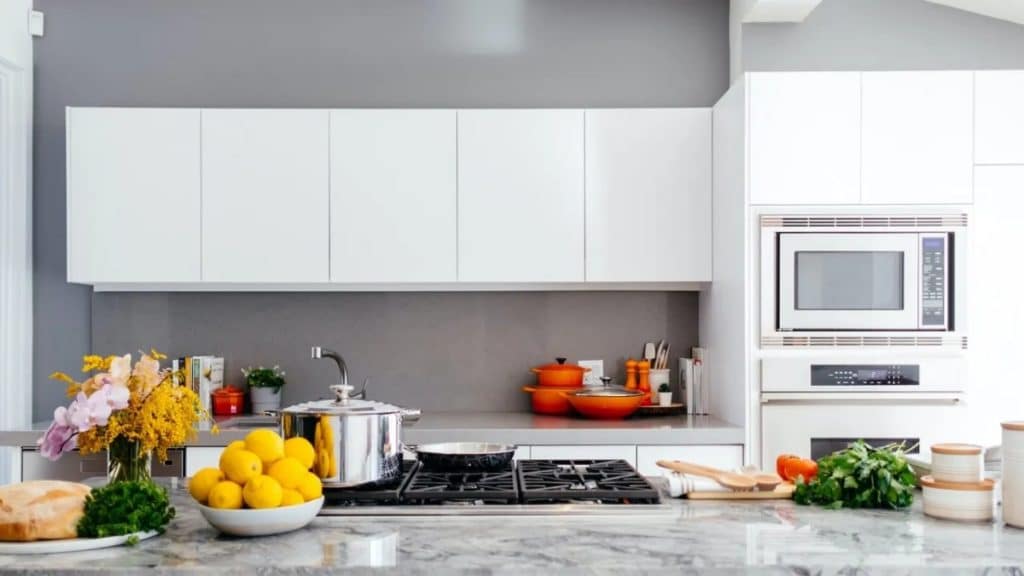Creating a healthy kitchen is about more than just aesthetics—it’s about designing a space that promotes nutritious eating habits, encourages better food preparation practices, and supports overall well-being. A healthy kitchen doesn’t just look good; it’s functional, clean, and organised in a way that inspires healthier lifestyle choices. Here are some key factors to consider when designing a healthy kitchen that supports you and your family’s well-being.
1. Maximise Natural Light and Ventilation
Good lighting and proper ventilation are essential for a healthy kitchen environment. Natural light helps create a bright, welcoming space while also having a positive impact on your mood and energy levels. Large windows, skylights, or glass doors can help maximise the amount of natural light entering your kitchen, making it a more pleasant place to spend time.
- Ventilation: Proper ventilation is crucial for removing cooking fumes, steam, and excess moisture, which can lead to mould and dampness. Invest in a good-quality extractor fan to ensure your kitchen stays fresh and free from pollutants. If possible, position your kitchen near windows that can be opened during cooking to let in fresh air.
2. Choose Healthy Materials
The materials you use in your kitchen can have a significant impact on your health. Opt for non-toxic, sustainable materials that won’t emit harmful chemicals into the air. Many modern kitchen materials are made with chemical treatments that can contribute to poor indoor air quality, so it’s essential to select eco-friendly and non-toxic options.
- Flooring: Choose materials like stone, stone effect tiles from mystonefloor.com or bamboo for your kitchen floors. These materials are not only durable but also eco-friendly and free from toxic chemicals.
- Countertops: Natural stone, wood, or stainless steel countertops are great choices for a healthy kitchen. These surfaces are easy to clean and are less likely to harbour bacteria, helping to promote food safety.
3 Encourage Healthy Eating with Smart Organisation
A well-organised kitchen makes it easier to access fresh, healthy ingredients and prepare nutritious meals. By keeping healthy foods visible and within easy reach, you’re more likely to make better food choices.
- Prioritise fresh produce: Designate a specific area in your fridge or pantry for fresh fruits, vegetables, and other healthy foods. Clear containers or open shelving can help ensure you can see these foods easily, making them the go-to option when you’re hungry.
- Accessible storage: Organise your kitchen so that nutritious ingredients and cooking tools are easy to reach. Store items like whole grains, nuts, seeds, and herbs in glass jars on open shelves, making them more visible and encouraging you to use them regularly.
4. Incorporate Space for Meal Prep
A healthy kitchen should make meal preparation enjoyable and convenient. Make sure to incorporate plenty of countertop space where you can comfortably chop, prepare, and cook meals. If possible, create dedicated zones for different kitchen tasks, such as prepping, cooking, and washing up.
- Multi-functional kitchen islands are an excellent addition to healthy kitchens, offering extra workspace for food prep while also providing a place to sit, socialise, or even eat meals.
- Built-in chopping boards or herb planters: Integrating small but practical elements, such as built-in chopping boards or planters for fresh herbs, can inspire healthier cooking habits.
5. Invest in Energy-Efficient and Healthy Appliances
The appliances you choose for your kitchen can also contribute to a healthier environment. Opt for energy-efficient appliances that use less electricity and help reduce your carbon footprint. More advanced kitchen appliances can also promote healthy cooking methods.
- Induction hobs: Induction hobs are a safer and healthier option compared to traditional gas or electric stoves. They cook food quickly and evenly while producing less indoor air pollution.
- Steam ovens and air fryers: Consider adding appliances that support healthier cooking techniques, such as a steam oven or an air fryer, which allows you to cook with less oil and maintain more nutrients in your food.
6. Incorporate Indoor Plants
Plants can significantly improve indoor air quality, adding a fresh and natural feel to your kitchen while removing toxins and boosting oxygen levels. Consider adding small potted plants or a vertical herb garden to your kitchen design. Herbs like basil, mint, and rosemary not only enhance your cooking but also thrive indoors.
Conclusion
Designing a healthy kitchen involves more than just selecting beautiful countertops and cabinets. It’s about creating a space that promotes healthy habits, improves air quality, and makes cooking and eating more enjoyable. By incorporating natural materials, smart organisation, energy-efficient appliances, and a touch of greenery, you can design a kitchen that supports your health and well-being for years to come.

